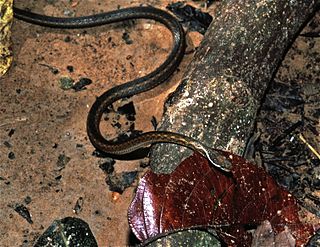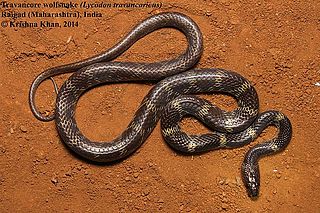
The Eastern Ghats are a discontinuous range of mountains along India's eastern coast. The Eastern Ghats pass through the states of Odisha and Andhra Pradesh to Tamil Nadu by, passing parts of Karnataka and Telangana on the way. They are eroded and cut through by four major rivers of peninsular India, viz., the Mahanadi, Godavari, Krishna and Kaveri. Jindhagada, or Seethamma Konda, is the highest point in both Andhra Pradesh and the Eastern Ghats, at 1,690 metres (5,540 ft). The Biligiriranga Hills in Karnataka are the tallest hill range in the Eastern Ghats, with many peaks above 1500 m in height.

The Bukit Timah Nature Reserve is a 1.7-square-kilometre (0.66 sq mi) nature reserve near the geographic centre of Singapore, located on the slopes of Bukit Timah Hill, the country's highest natural peak standing at a height of approximately 165-metre (541 ft), and parts of the surrounding area. The nature reserve is about 15 kilometres from the Downtown Core, Singapore's central business district (CBD).

Calotes maria, called commonly the Khasi Hills forest lizard or Assam garden lizard, is a species of lizard in the family Agamidae. The species is endemic to South Asia.
Colonel Richard Henry Beddome was a British military officer and naturalist in India, who became chief conservator of the Madras Forest Department. In the mid-19th century, he extensively surveyed several remote and then-unexplored hill ranges in Sri Lanka and south India, including those in the Eastern Ghats such as Yelandur, Kollegal, Shevaroy Hills, Yelagiri, Nallamala Hills, Visakhapatnam hills, and the Western Ghats such as Nilgiri hills, Anaimalai hills, Agasthyamalai Hills and Kudremukh. He described many species of plants, amphibians, and reptiles from southern India and Sri Lanka, and several species from this region described by others bear his name.

Hebius khasiensis, commonly known as the Khasi Hills keelback or Khasi keelback, is a species of colubrid snake endemic to southeastern Asia.
Blythia reticulata, commonly known as Blyth's reticulate snake, Blyth's reticulated snake, or the iridescent snake, is a species of snake in the subfamily Natricinae of the family Colubridae of the superfamily Colubroidea. The species is endemic to Asia.

Oreocryptophis porphyraceus is a rat snake species, commonly called the black-banded trinket snake, red bamboo snake, found in mid to upper-level elevations of forested hills in southeastern Asia, ranging from evergreen tropical to dry seasonal forests depending on the subspecies and locality. It is the only member of the genus Oreocryptophis, but it was formerly placed in Elaphe.
The eastern trinket snake is a species of snake in the family Colubridae. The species is endemic to South Asia.

Lycodon travancoricus, commonly known as the Travancore wolf snake, is a species of colubrid snake endemic to south India.

Sibynophis collaris, commonly known as the common many-toothed snake,Betty's many toothed snake or the collared black-headed snake, is a species of colubrid snake endemic to South and East Asia.
The Khasi Hills bent-toed gecko is a species of gecko found in Asia.

Takydromus khasiensis is a species of lizard. It is found in Northeast India, adjacent Myanmar (=Burma), and northern part of Bangladesh. The type locality is the Khasi Hills.

Limnonectes palavanensis is a species of frog in the family Dicroglossidae. It is found in the Palawan Island and in Borneo. The species shows paternal care, a relatively rare trait in frogs.
Garthius chaseni, commonly known as Chasen's mountain pit viper, Chasen's tree viper, and the Kinabalu brown pit viper, is a species of venomous pitviper in the family Viperidae. The species is endemic to the island of Borneo in Malaysia. No subspecies are currently recognized. It is monotypic in the genus Garthius.

The Borneo lowland rain forests is an ecoregion, within the tropical and subtropical moist broadleaf forests biome, of the large island of Borneo in Southeast Asia. It supports approximately 15,000 plant species, 380 bird species and several mammal species. The Borneo lowland rain forests is diminishing due to logging, hunting and conversion to commercial land use.
Stoliczkia is a genus of snakes in the family Xenodermidae. The genus contains two species, both from India.

Paraxenodermus borneensis is a species of snake in the family Xenodermatidae. It is endemic to Borneo and known from Sabah, Sarawak (Malaysia), and West and Central Kalimantan (Indonesia). The holotype was collected from Mount Kinabalu by Richard Hanitsch.

Xenodermidae is a family of snakes native to East Asia, South Asia, and Southeast Asia. All species in the family Xenodermidae are small or moderately sized snakes, never more than 80 cm (31 in) but typically less than 55 cm (22 in) in total length. They are secretive, probably nocturnal, and typically inhabit moist forest habitats. They seem to be opportunistic carnivores, preying on other vertebrates.

Hebius is a genus of snakes in the family Colubridae.













